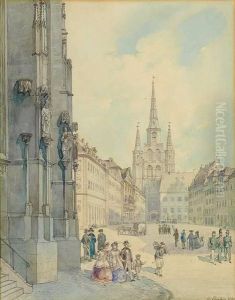Georg Eberlein Paintings
Georg Eberlein was a 19th-century German architect and painter, known for his contributions to the Neo-Gothic architectural movement in Germany. Born on March 12, 1831, in Schweinfurt, Bavaria, Eberlein grew up during a period of revivalist architecture where there was a strong interest in medieval styles, particularly Gothic.
Eberlein's education and early career are not as widely documented as those of some of his contemporaries. However, it is known that he demonstrated artistic promise at a young age and likely received formal training in architecture and the arts. His work was heavily influenced by the Gothic Revival, an architectural movement that sought to revive Gothic designs and was part of a broader cultural movement that romanticized the Middle Ages.
During his career, Eberlein was involved in the design and restoration of several churches and other structures in the Gothic style. His work often included elaborate stone carvings, pointed arches, and ribbed vaults, which are characteristic of the Gothic architecture that was prevalent in Europe from the 12th to the 16th centuries. Eberlein's attention to historical detail and his ability to adapt the Gothic style to contemporary needs earned him a reputation as a skilled architect.
Aside from his architectural work, Eberlein was also a talented painter. His paintings, though less known than his architectural designs, reflected his interest in medieval themes and often depicted religious and historical subjects. He was part of a larger group of artists and architects who sought to create works that were not only aesthetically pleasing but also imbued with moral and spiritual significance.
Georg Eberlein's career spanned several decades, during which he made significant contributions to the architectural landscape of Germany. His commitment to the Neo-Gothic style helped to ensure its continued popularity throughout the 19th century and beyond. Eberlein died on February 14, 1904, in Munich, Germany. Though not as celebrated as some of his contemporaries, his work remains an important part of the architectural history of the period and continues to be studied by historians and scholars interested in the Gothic Revival movement.
